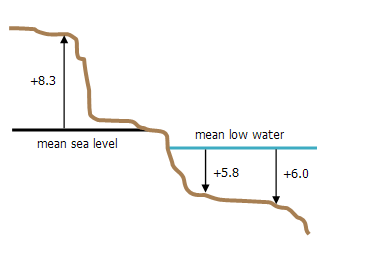A vertical coordinate system defines the origin for height or depth values. Like a horizontal coordinate system, a vertical coordinate system ensures that data is spatially located accurately in relation to other data. This is especially important if you will edit the data, create new data, or perform analysis.
A vertical coordinate system includes a unit of measure. This is always a linear unit, usually feet or meters. A vertical coordinate system also includes a direction. This specifies whether values are positive up, representing heights above a surface, or positive down, indicating that values are depths below a surface. The following diagram shows two vertical coordinate systems: mean sea level and mean low water. Mean sea level is used as the zero level for height values. Mean low water is a depth-based vertical coordinate system.

One z-value is shown for the height-based mean sea level system. Any point that falls below the mean sea level line but is referenced to it has a negative z-value. The mean low water system has two z-values associated with it. Because the mean low water system is depth-based, the z-values are positive. Any point that falls above the mean low water line but is referenced to it has a negative z-value.
Dive-in:
When you work with gravity-based heights (elevations), the vertical data is drawn relative to the ellipsoidal surface display in the global scene.
Specify a vertical coordinate system on a map or scene
To specify a vertical coordinate system, complete the following steps:
- In the Contents pane, right-click a map or a scene and click Properties.
- On the Map Properties dialog box, click the Coordinate Systems tab.
The Current Z boxes show the current vertical coordinate system of the map or scene. There may be no vertical coordinate system defined. If one is defined, click Details above the Current Z box to see how it is defined.
- To choose a vertical coordinate system or change to a different one, click the Current Z box to highlight it. Choose an appropriate coordinate system from the corresponding Z Coordinate Systems Available list. Enter a search term in the Search box to help locate a specific coordinate system.
Vertical coordinate systems in a global scene must be ellipsoidal. They can be gravity-based only if they cover a full world extent. EGM2008 Geoid and EGM96 Geoid are examples of global gravity-based vertical coordinate systems.
When the vertical coordinate system is ellipsoidal, it must share the same datum as the horizontal coordinate system. The datum name, the spheroid name, and all of the spheroid properties of the two coordinate systems must exactly match.
- To remove a vertical coordinate system definition from a map or a scene, click Current Z and choose
 <None> from the Z Coordinate Systems Available list.
<None> from the Z Coordinate Systems Available list.
- Download the list of supported geographic and vertical coordinate systems.
- Download the list of supported projected coordinate systems.
- Download the list of supported geographic and vertical transformations.